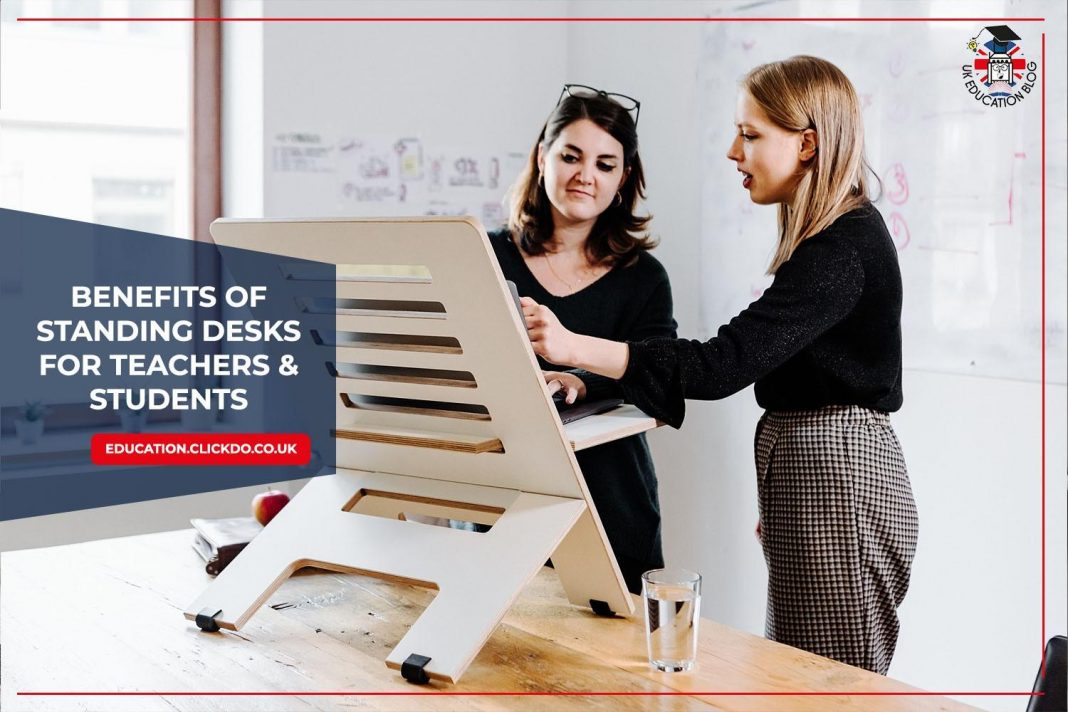In today’s classrooms, standing desks are becoming increasingly popular to improve student learning and engagement and the well-being of all.
In a study released by the Office for National Statistics in 2018, one of the four most common reasons for sickness absence of musculoskeletal problems (including back pain and neck and upper limb problems).
With many education settings grappling with student absenteeism and increased staff absences, standing desks could improve the situation. Standing desks are not only beneficial for students’ and educators’ physical health, but they can also help to create a more productive learning environment, improve focus, and promote better posture.
In this article, we will explore the benefits of using standing desks in the classroom and discuss why they are becoming an increasingly popular choice for educators and schools.
The top 6 Benefits of using Standing Desks in Education
 1. Better Physical Health
1. Better Physical Health
 Standing desks can help to improve students’ and educators’ physical health by reducing the amount of time they spend sitting in one position. This can help to reduce the risk of developing poor posture, back pain, and other health problems associated with prolonged sitting.
Standing desks can help to improve students’ and educators’ physical health by reducing the amount of time they spend sitting in one position. This can help to reduce the risk of developing poor posture, back pain, and other health problems associated with prolonged sitting.
Additionally, standing desks can help to increase students’ and educators’ energy levels and alertness, which can lead to improved focus and engagement in the classroom.
2. Increased Focus
 Standing desks can help to improve student and educator focus by allowing them to move around and change positions throughout the day. This can help to reduce fatigue and increase engagement in the classroom.
Standing desks can help to improve student and educator focus by allowing them to move around and change positions throughout the day. This can help to reduce fatigue and increase engagement in the classroom.
Additionally, standing desks can help to reduce distractions by allowing students to stand away from other students who may be disruptive.
3. Improved Posture
 Standing desks can help to improve students’ and educators’ posture by encouraging them to stand upright and maintain good posture while at school. This can help to reduce the risk of developing poor posture, which can lead to a variety of health problems.
Standing desks can help to improve students’ and educators’ posture by encouraging them to stand upright and maintain good posture while at school. This can help to reduce the risk of developing poor posture, which can lead to a variety of health problems.
Additionally, good posture can help to improve students’ focus and concentration, which can lead to better academic performance.
4. Higher Productivity
 Standing desks can help to increase student and educator productivity by encouraging physical activity which stimulates the mind and brain activity. Engaging in theoretical activities combined with physical movement activates muscle memory as well.
Standing desks can help to increase student and educator productivity by encouraging physical activity which stimulates the mind and brain activity. Engaging in theoretical activities combined with physical movement activates muscle memory as well.
Memorization and recall are enhanced and lead to higher productivity when engaged in tasks or assignments.
5. Increased Energy
 Standing desks can help to increase energy levels in the classroom by allowing students and educators to move around and get their blood circulating. This can help to keep students alert and focused, leading to better learning outcomes.
Standing desks can help to increase energy levels in the classroom by allowing students and educators to move around and get their blood circulating. This can help to keep students alert and focused, leading to better learning outcomes.
The EZ Shopper standing desk for example is an adjustable desk, which is designed with a wide range of heights, so students and educators of all sizes can find a comfortable position to work in. It also features a spacious work surface, making it easy for its users to spread out their materials and work efficiently.
Additionally, it is easy to assemble, making it a great choice for educators who want to quickly and easily set up a standing desk in their classroom.
Why is standing up while learning more effective?
 Standing up when answering questions, doing quizzes or exams helps the student stay focused and engaged in the lesson. It also helps to create a sense of order in the classroom and can help the teacher to better assess the student’s well-being.
Standing up when answering questions, doing quizzes or exams helps the student stay focused and engaged in the lesson. It also helps to create a sense of order in the classroom and can help the teacher to better assess the student’s well-being.
Additionally, standing up when answering questions can help to increase the student’s confidence and self-esteem, as it shows that they have the courage to speak up and be heard in front of the class.
Finally, standing up can also help to improve posture and blood circulation, which can lead to better overall health and well-being.
Is it better to sit or stand while studying?
A lot of research has been done on the effects of sitting and standing on learning outcomes.
Generally, the consensus is that standing is better for learning than sitting. Studies have shown that standing desks can improve concentration, reduce distractions, and increase engagement.
Additionally, standing can help to improve posture and reduce back pain. A standing desk can be more beneficial if used properly, by alternating between sitting and standing throughout the day and by following the recommended height guidelines for a more comfortable posture.
Ultimately, the decision of whether to sit or stand while studying should depend on the individual and their needs. Some people may find that they are more productive while sitting, while others may find that they are more productive while standing.
It is important to experiment and find out what works best for everyone. However, to maintain a good posture throughout the day and taking regular breaks in order to keep the mind and body engaged while at school is a key elements of a healthy lifestyle.
Author Profile

- Editor in Chief
- Blogger and Educator by Passion | Senior Online Media & PR Strategist at ClickDo Ltd. | Contributor to many Education, Business & Lifestyle Blogs in the United Kingdom & Germany | Summer Course Student at the London School of Journalism and Course Instructor at the SeekaHost University.
Latest entries
 Directory PostsOctober 29, 20257 Not-To-Miss UK Education Conferences in 2026
Directory PostsOctober 29, 20257 Not-To-Miss UK Education Conferences in 2026 Directory PostsOctober 16, 2025The 12 Best Online Tutoring Platforms in the UK
Directory PostsOctober 16, 2025The 12 Best Online Tutoring Platforms in the UK Directory PostsOctober 6, 2025Top 12 London Private Schools – Best Independent Schools Nearby
Directory PostsOctober 6, 2025Top 12 London Private Schools – Best Independent Schools Nearby careerSeptember 10, 20258 Top Online Future Career Courses To Know
careerSeptember 10, 20258 Top Online Future Career Courses To Know







